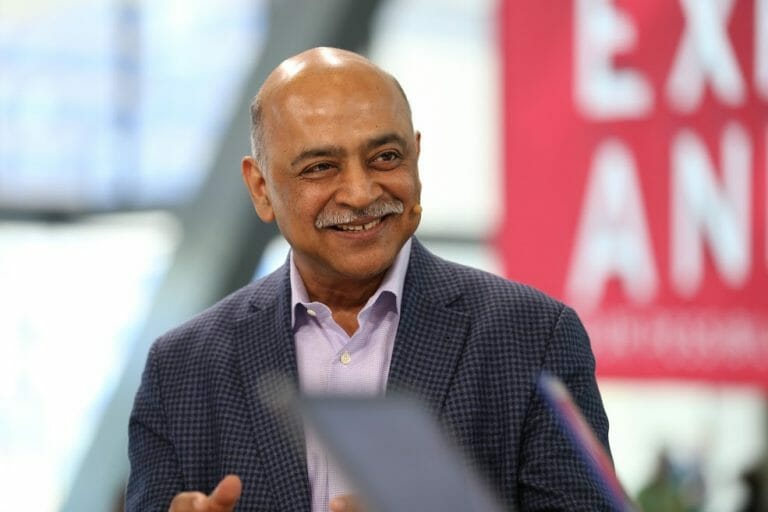On Jan. 30—before the world had even a thought about masks, social distancing, ventilators and WFH—IBM announced that longtime top technologist Arvind Krishna would take over as CEO on April 6.
But when that date arrived, Krishna had much more to deal with than COVID’s repercussions as the low-growth tech icon’s all-in bet on Red Hat was only beginning to play out.
Imagine the emotional roller-coaster Krishna was on, from late January when the board announced his upcoming appointment until April 6 when he took the CEO reins:
- after 30 years of imagining and leading the creation of a wide range of vital technologies for IBM, Krishna was about to become the first technologist to lead the storied company;
- the Red Hat acquisition that he drove was becoming the centerpiece of IBM’s strategy; and
- as the company transitioned to being cloud-first, the marketplace was clearly on fire with cloud fever; and
- then, in mid-March, everything changed. Instantly. Profoundly. Jarringly.
So why do I believe Arvind Krishna deserves an A+ for his performance in his debut quarter at the top of IBM?
- On Krishna’s first day as CEO, IBM released a LinkedIn article in which Krishna outlined his vision for and concerns about the company. He said all the right things about the COVID crisis, and also outlined a solid strategy for the company. So, in this crucial first step, he instilled calm and confidence.
- My reaction to that first-day vision was a piece called Will IBM’s New CEO Shake Up the Company or Simply Shuffle the Pieces? In that, I wrote, “In framing my question above about new CEO Krishna’s willingness and ability to shake up the company on an ongoing basis, I don’t mean to cast any doubt on his ability to do what’s needed. Rather, my point is that disruptive and high-level change is taking place constantly among IBM’s primary competitors so Krishna has to be able to transform his company not at a pace that venerable IBM itself prefers but instead at the frenetic pace of the external world.”
And I highlighted two essential points Krishna made in his first-day memo that pointed to his willingness to make high-level changes:
- “We must all be obsessed with continually delighting our clients.”
- “Howard Boville will join IBM from Bank of America on May 1st to become Senior Vice President of Cloud Platform, overseeing the IBM Cloud.”
On the first point, IBM’s tangled org structure has often meant that internal sales teams are obsessed with outdoing each other rather than with dazzling their clients. Krishna has begun weeding out that insidious infighting by putting SVP Mark Foster in charge of both of the company’s two huge services units: Global Business Services and Global Technology Services, which together account for about $48 billion in annual revenue and include 240,000 employees.
On the second point, the formerly balkanized cloud business is now run by not only an outsider but by a *customer* who will surely bring a fresh new perspective to IBM’s do-or-die cloud business.
- A few days after taking over as CEO, Krishna did an interview with CNBC’s Jon Fortt. Fortt asked Krishna how he planned to compete against Amazon, Microsoft and Google. As I outlined in How IBM’s New CEO Plans to Beat Microsoft, Amazon & Google in Cloud, Krishna focused his answer on the deep-tech trio of Linux, Kubernetes and containers, which I thought was entirely the wrong answer. Instead, I argued, “do those business leaders really want to muck around in the deep details of Linux, containers and Kubernetes when the questions uppermost in their minds are:
- how do I keep my revenue from going through the floor during this slowdown?
- as things begin to return to normal, how do I strike the right balance with WFH?
- with Q3 and Q4 approaching, how will I get my revenue on the move again?
- how do I gain end-to-end visibility of my supply chain so I never get caught short again?
- how do I gain full transparency into my demand chain so I can move at the speed of the market?
- when it comes to digital transformation, how do I reframe my initiatives so that they include all those questions without slowing me down?”
Earlier this week, during IBM’s Q2 earnings call, Krishna certainly made the case where needed that IBM’s and Red Hat’s technological expertise will continue to be indispensable. But he also talked much more about customer needs and requirements. In doing so, he stepped more fully into the persona of the CEO rather than that of the 30-year technology leader.
- For Krishna’s debut quarter as CEO, IBM’s cloud revenue grew 34% to $6.3 billion. Yes, some of that figure can be attributed to one-time accounting requirements as the Red Hat financials are once and for all fused into IBM’s numbers, but the facts remain. For the quarter ended June 30, IBM’s cloud business grew 34% to $6.3 billion. For the sake of comparison, look at Microsoft’s cloud numbers for the same period: while Microsoft’s cloud revenue for those 3 months ($14.3 billion) was more than twice that of IBM’s, Microsoft’s growth rate for the cloud was 32% and IBM’s was 34%.
- Krishna has simplified IBM’s formerly tortured cloud messaging. He simply refers to it now as “hybrid cloud platform,” and that includes all $23 billion in trailing 12-month cloud revenue. I can’t say I love that name, but it sure is a whole lot better than what it had been, and “hybrid cloud platform” plays into some of today’s key market dynamics.
So, well done, Arvind Krishna! And to keep the momentum going at this company that means so much to you (in his first-day memo, Krisha’s final paragraph began with “I love this company”), keep hammering away at org structures that foster internal mud-wrestling versus customer obsession; keep connecting the disparate parts of your company that, when fused, can be enormously valuable to customers; and keep packaging the amazing technology that IBM develops in ways that appeal to the deepest needs of your customers.
RECOMMENDED READING
Will IBM’s New CEO Shake Up the Company or Simply Shuffle the Pieces?
How IBM’s New CEO Plans to Beat Microsoft, Amazon & Google in Cloud
IBM CEO Arvind Krishna Shares Powerful Vision for $1.2 Trillion Hybrid Cloud
Google Cloud Booms: Thomas Kurian’s Vision for World’s Fastest-Growing Cloud
Larry Ellison’s Miracle: Oracle Becomes Big-Time Cloud Infrastructure Player
Why Larry Ellison and Oracle Are Reinventing the Language of the Cloud
SAP’s Secret Weapon: Month-Old Industry Cloud Already ‘Growth Driver’
ServiceNow Will Triple Workforce in 5 Years, Says CEO Bill McDermott
Oracle Cloud Is So Hot Even Legendarily Cynical Gartner Analyst Likes It!
Larry Ellison’s 3-Point Plan to Beat Amazon: Autonomous, Performance, Security
Subscribe to the Cloud Wars Newsletter for in-depth analysis of the major cloud vendors from the perspective of business customers. It’s free, it’s exclusive and it’s great!








